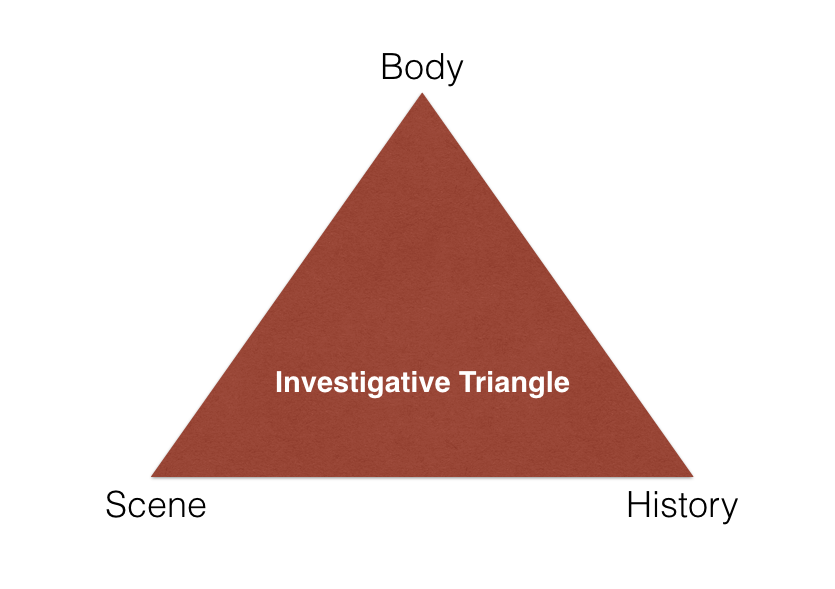 Every crime scene presents unique obstacles for the investigator, but in a death investigation three elements will always exists to some degree. These three elements make up the investigative triangle.
Every crime scene presents unique obstacles for the investigator, but in a death investigation three elements will always exists to some degree. These three elements make up the investigative triangle.
Although independent in nature – they are interdependent in the investigation. A complete and accurate investigation can not be accomplished without weaving these three elements together.
These element are
- The Scene
- The Body
- The History
The Scene
The scene of every death contains facts of the story. Regardless of the amount of actual physical evidence, the scene does tell a portion of the story; every scene must be worked slowly and methodically. It is our responsibility to listen to that story and let the evidence and subsequent facts, complete the story. The scene may be one location, or many. Evidence can be overwhelming in scope, or minimal at best.
Cooperation between police investigators and the Coroner/ ME offices is critical. Each agencies has a major, and no less important, function in the overall investigation of any death scene. Agencies should have an attitude of cooperation and communicate each other’s roles clearly prior to any scene presenting itself. Neither agency can properly perform their function without the information and cooperation of the other.
The Body
The body is the most important piece of evidence of any death scene. Without a body, you have do not a death scene, (even if the body is presumed dead and ordered so by the courts) . Information from the body is what directs the investigation. First, there must be a body. Then a determination of cause and manner will direct further investigation. Evidence such as recovered bullets, wound patterns, DNA, wound type and trajectory, are just the basic information located within the body. In most states, the Coroner/ME investigators have complete control of the body and everything associated with it. Although it is part of the scene, it is a scene within itself. Here again is where prior communication and complete cooperation is a must between agencies. Questions such as collecting evidence, initial photographs, movement of the body, and access for time of death determination needs to have an attitude of cooperation.
History
Decedent history is the third element of the investigative triangle and an equally important aspect of every death investigation. Anti-mortem activity should be known of every decedent to establish the activities immediately prior to death; although that time frame can be minutes or hours. An effort must be made to obtain medical history, psychological history, as well as social and sexual history, any and all of these can yield information necessary to establish cause and manner, as well as establish a suspect.
In this episode:
This episode is a panel discussion of the three elements of the investigative triangle and how best to approach each one. I have included two experts from different parts of the United States as well as differing primary roles of investigation as well as myself; to discuss at length this investigative triangle approach to death investigation.
Everette Baxter Jr.
Supervising Crime Scene Investigator with the Oklahoma City, OK Police Department
Paul Parker
Assistant Coroner Clark County Nevada – Las Vegas

